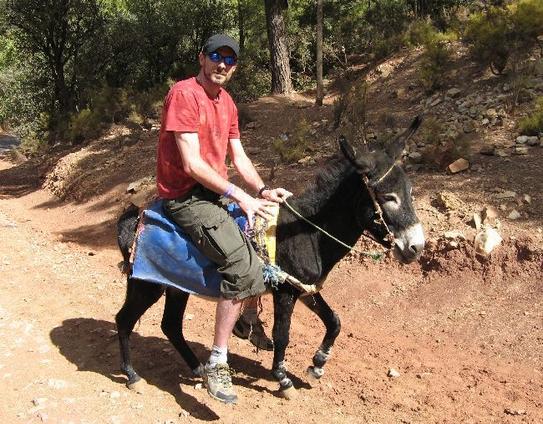#JuliaDucournau 's #French and #Berber language body horror drama #Alpha - starring #TaharRahim, #GolshiftehFarahani, #MélissaBoros, #EmmaMackey, #FinneganOldfield and #LouaiElAmrousy - begins my film quadruple and first in #HOMEmcr
#berber
Marokko: Auf ins Land der Berber zwischen Souss und Massa – Teil 1
https://reisefreak.de/marokko-auf-ins-land-der-berber-zwischen-souss-und-massa/
Infobox
Autor:
Wolfgang Brugger
Reisezeit:
Juli 2018
Art der Reise:
Pressereise
#Marokko #ReiseBerichte #Agadir #AitBaha #Argan #Arganl #Berber #Inzerki #Marokko #Marokko18 #Massa #Pressereise #Reise #Reisebericht #Reisebericht18 #Souss #SoussMassa #Sdmarokko #Tafraout #Tamraght #Taroudant #Tifnit #Urlaub
Beduí realitzat amb tinta i fons d'aquareŀla retocat.
#pocpaper #aquarela #aquarella #aquarellart #acuarela #watercolor #watercolour #mastoart #creativetoots #penandink #ink #berber #arab #fediart
South Morocco Berber house in small hamlet on the Souss Massa Nati 🏝️
The #house has been simply or essentially renovated and creatively furnished in a #Berber style
The adjoining #garden are planted with over 70 aloe vera plants: #olives, #palm trees, #caruba, #succulents, #hibiscus, #pomegranate 🪴
Approx. 40 minutes' walk over #dunes to the wide #Atlantic #beach 🏄♀️
Rooms: 4
Living space: 65m²
Plot: 270m²
#Agadir #Morocco 🇲🇦
52.000 €
“What Do You Want Money for?”: A Chain Tale [pdf 16pp] #folktales #ChainTale #Berber #Songhay #TalkingCat https://oraltradition.org/wp-content/uploads/01-Souag-Final.pdf
St. Augustine of Hippo
St. Augustine of Hippo was a theologian & philosopher of Berber origin & the bishop of Hippo Regius in Numidia, Roman North Africa. Hippo Regius is in modern-day Annaba, Algeria. He was born I 354 in the municipium of Thagaste (now Souk Ahras, Algeria) in the Roman province of Numidia.
His mom, Monica/Monnica, was a devout Christian. His dad, Patricius, was a pagan, who converted to Christianity on his deathbed. Augustine, in his writings, mentions his identity as a Roman African.
His writing deeply influenced the development of Western philosophy & Western Christianity. He’s viewed as one of the most important Church Fathers of the Latin Church in the Patristic Church.
Patristics, a.k.a. Patrology, is a branch of theological studies focused on the writings & teachings of the Church Fathers, between the 1st-8th century AD.
St. Jerome said of Augustine: he “established anew the ancient Faith.”
In his youth, he was drawn to the Manichaean faith & later to the Hellenistic philosophy of Neoplatonism. After his conversion to Christianity & baptism in 386, Augustine developed his own approach to philosophy & theology, that had a variety of methods & perspective.
Believing the grace of Chris was indispensable to human freedom, he helped formulate the doctrine of original sin & made significant contributions to the development of just war theory.
The just war theory is a doctrine of military ethics that aims to ensure that a war is morally justifiable through a series of criteria, all of which must be met for a war to be considered just.
When the Western Roman Empire began to fall apart, Augustine imagined the Church as a spiritual City of God, which is distinct from the material Earthly City.
There’s a segment of the Church that follows the concept of the Trinity as defined by the Council of Nicaea & the Council of Constantinople closely identified with Augustine’s On the Trinity.
Augustine is recognized as a saint in the Catholic Church, the Eastern Orthodox Church, Lutheran church, & Anglican church. He’s also a Catholic “Doctor of the Church.” And he’s the patron of the Augustinians. His feast day is on August 28th, the day he passed away. The Church of England also celebrates August 28th as his feast day. In the Greek & Russian Orthodox Churches, his feast day is June 15. He’s the patron saint of brewers, printers, theologians, & a number of cities & dioceses.
Many Protestants, especially Calvinists & Lutherans, consider Augustine one of the theological fathers of the Protestant Reformation due to his teachings on salvation & divine grace.
In the East, Augustine’s teachings are disputed. The most controversial doctrine associated with him is the filioque. It was rejected by the Eastern Orthodox Church. Other disputed teachings include Augustine’s views on original sin, the doctrine of grace, & predestination. Despite this, Augustine is considered mistaken on some points, he’s still considered a saint.
Filioque is a Latin phrase meaning “and the Son.” This was added to the Nicene Creed by the Western Church to clarify that the Holy Spirit proceeds “from the Father & the Son.”
In 1842, a portion of Augustine’s right arm (cubitus) was secured from Pavia & returned to Annba. It now rests in St. Augustin Basilica within a glass tube inserted into the arm of a life-sized marble statue of the saint. It’s considered a relic.
Augustine was canonized by popular acclaim. He was later recognized as a Doctor of the Church in 1298 by Pope Boniface VIII.
One-Time Monthly YearlyMake a one-time donation
Make a monthly donation
Make a yearly donation
Choose an amount
$5.00 $15.00 $20.00 $1.00 $5.00 $10.00 $5.00 $10.00 $15.00Or enter a custom amount
$Your contribution is appreciated.
Your contribution is appreciated.
Your contribution is appreciated.
DonateDonate monthlyDonate yearly
#1298 #1842 #1stCenturyAD #354 #386 #8thCenturyAD #Algeria #AnglicanChurch #Annaba #August28 #Augustinians #Berber #Calvinists #CatholicChurch #Christ #Christianity #ChurchFathers #ChurchOfEngland #CouncilOfConstance #CouncilOfNicaea #Cubitus #DivineGrace #DoctorOfTheChurch #DoctrineOfGrace #EasternOrthodoxChurch #Filioque #GreekOrthodox #Hellenistic #HippoRegius #JustWarTheory #LatinChurch #LutheranChurch #Lutherians #Manichaeism #Municipium #Neoplatonism #NorthAfrica #Numidia #OriginalSin #PatristicChurch #Patrology #Pavia #PopeBonifaceVIII #Predestination #ProtestantReformation #Protestants #relics #RomanAfrican #RomanNorthAfrica #RussianOrthodox #SoukAhras #StAugustinBasilica #StAugustineOfHippo #StJerome #Thagaste #Trinity #WesternRomanEmpire
Die Safranfrau (Christine Ferrari & Andrea Micus): wie eine Schweizerin im Ourika-Tal ihr Glück fand https://www.lesering.de/id/4941084/die-safranfrau-rezension-inhalt-kritik/ #ChristineFerrari #Buchrezension #Buchrezension #AndreaMicus #Ourika-Tal #Marrakesch #Biografie #Safran #Berber
Ancient Berber Cities, Tunisia
https://www.youtube.com/watch?v=c_YbbcdWwnU
> The abandoned villages/cities of #Guermassa, #Douiret, and #Chenini in the #Dahar Mountains in Southern Tunisia, are enduring remnants of #Berber #heritage. Guerma...
Denizin altında tıraş yaptı, 1 günde 1,5 milyon izlendi: Ortaokul çağlarında çırak olarak başlayıp amcasından öğrendiği berberlik mesleğini 10 yıl önce bırakan Baytan, 5 ay önce dostlarının teşvikiyle yeniden dükkanını açtı. Ancak çevresindeki bazı kişiler, mesleğinde köreldiğini ve bu işi yeniden başaramayacağını iddia etti. Baytan, "Artık yapamazsın, körelmişsindir" sözlerine karşılık, deniz altında… https://www.eshahaber.com.tr/haber/denizin-altinda-tiras-yapti-1-gunde-1-5-milyon-izlendi-242024.html?utm_source=dlvr.it&utm_medium=mastodon EshaHaber.com.tr #tıraş #berber #viral #denizaltı #sosyalmedya
Berber ve kuaförlere zam: Ense tıraşı 150 lira: Yapılan açıklamada, ekonomik koşullar ve giderlerdeki artış nedeniyle tarifede güncellemeye gidildiği belirtilerek, vatandaşların yeni fiyatlar konusunda bilgilendirileceği ifade edildi. Zamlı tarifelerin tüm berber ve kuaför salonlarında görünür şekilde asılması zorunlu olacak.
SAÇ SAKAL 500 TL, SAKAL TIRAŞI 150 TL, ENSE TIRAŞI 150 TL
Yeni fiyatlara göre… https://www.eshahaber.com.tr/haber/berber-ve-kuaforlere-zam-ense-tirasi-150-lira-240248.html?utm_source=dlvr.it&utm_medium=mastodon EshaHaber.com.tr #berber #kuaför #zam #fiyatlar #ekonomi
Die "Mausūʿat at-turāṯ al-amāzīġī" ist eine monumentale 12-bändige #Enzyklopädie, die das reiche Erbe der #Berber Nordafrikas in sozialen, kulturellen und politischen Dimensionen umfassend dokumentiert. Mit ihrem interdisziplinären Ansatz bietet das Werk einzigartige Einblicke in die facettenreiche Geschichte des #Maghreb.
État d'avancement de la traduction collaborative de certains composants du « TranslationProject » en #Kabyle.
Traduction « privée » sur invitation effectuée par l'équipe `kab-l10n` connue sous le nom kabyle « Imsidag » / localizers.
- La commande `grep` : 98%
- La commande `wget` : 66%
Les composants verrouillés ont déjà été envoyés au projet upstream.
Tıraş olan kardeşini öldüren ağabey tutuklandı: Samsun'da berber dükkanında kardeşi Barış Kol'u (43) silahla vurarak öldüren ağabey Ahmet Kol (46) ve olaydan sonra işyerine ve evine gittiği Aslan S. ve Murat S., Cinayet Bürosu ekipleri tarafından gözaltına alındı. Savcıya ifade veren 3 kişi, nöbetçi mahkemeye sevk edildi. Nöbetçi mahkemeye ifade veren Ahmet Kol tutuklanırken, Aslan S. ve Murat S.… https://www.eshahaber.com.tr/haber/tiras-olan-kardesini-olduren-agabey-tutuklandi-229202.html?utm_source=dlvr.it&utm_medium=mastodon EshaHaber.com.tr #Tıraş #KardeşCinayeti #Samsun #Berber #Tutuklama
Berber koltuğunda kardeşe kanlı infaz! Katil ağabeyin ifadesi ortaya çıktı: Samsun'da berber dükkanında kardeşi Barış Kol'u öldüren ağabey Ahmet Kol, poliste susma hakkını kullanarak ifade vermedi. Ahmet Kol'un savcılık ifadesi ortaya çıktı.
“BİR ANLIK PANİKLE BENİ VURABİLECEĞİ ENDİŞESİ İLE ATEŞ ETTİM”
Savcılık ifadesinde kendini savunan Ahmet Kol, "Kendisi ile daha öncesinde herhangi bir husumetim yoktu.… https://www.eshahaber.com.tr/haber/berber-koltugunda-kardese-kanli-infaz-katil-agabeyin-ifadesi-ortaya-cikti-229201.html?utm_source=dlvr.it&utm_medium=mastodon EshaHaber.com.tr #berber #infaz #katil #suç #Samsun
Habervip habervip Bursa'da berber dükkanında silahlı saldırı sonucu hayatını kaybeden çırak için adalet aranıyor https://www.habervip.org/son-dakika/bursada-berber-dukkaninda-silahli-saldiri-sonucu-hayatini-kaybeden-cirak-icin-adalet-araniyor/882?utm_source=dlvr.it&utm_medium=mastodon Detay:habervip.org Takipte kalın #Bursa #berber #adalet #saldırı #cinayet
Quelques infos à propos de la police de caractères : Amazigh-Motifs via FontForge.
Bergama'da berberlerden CHP'li Belediye'ye tepki: Ücretsiz saç kesimi esnafı böldü https://www.kocaelihaberdar.com.tr/gundem/bergamada-berberlerden-chpli-belediyeye-tepki-ucretsiz-sac-kesimi-esnafi-boldu/21553123 #Bergama #Berber #Esnaf
#Shuffle
Mahli (remix) (2005) by Souad Massi
This track starts low, then gradually builds up. This is from her album Mesk Elil (Honeysuckle).
It is a remix of Ilham also on the album.
Souad Massi
#Music #Algeria #Berber











